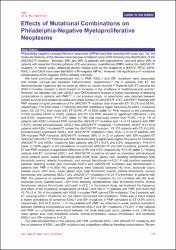Effects of mutational combinations on philadelphia-negative myeloproliferative neoplasms

Göster/
Erişim
info:eu-repo/semantics/openAccessTarih
2017Yazar
Yönal-Hindilerden, İpekDağlar-Aday, Aynur
Hindilerden, Fehmi
Nalcacı, Meliha
Akif, Selim Yavuz
Sargın, Deniz
Üst veri
Tüm öğe kaydını gösterKünye
Yönal-Hindilerden, İ., Dağlar-Aday, A., Hindilerden, F., Nalcacı, M., Akif, S. Y. ve Sargın, D. (2017). Effects of mutational combinations on philadelphia-negative myeloproliferative neoplasms. Iranian Journal Medical Sciences, 42(2), 219-220.Özet
Philadelphia-negative myeloproliferative neoplasms (MPNs) were first described 65 years ago. Yet, the molecular features of the disease have become of interest since 2005 following the identification of the JAK2V617F mutation.1 Between 90% and 98% of patients with polycythemia vera and about 50% of patients with essential thrombocythemia (ET) and primary myelofibrosis (PMF) harbor the JAK2V617F mutation.2 In recent years, additional genetic factors such as the mutations of IDH1/2, TET2, EZH2, ASXL1, and CALR have been identified in Ph-negative MPNs.3 However, the significance of mutational combinations on Ph-negative MPNs remains unknown.

















